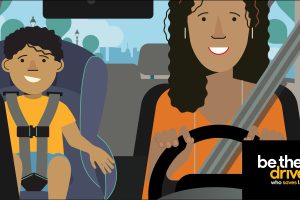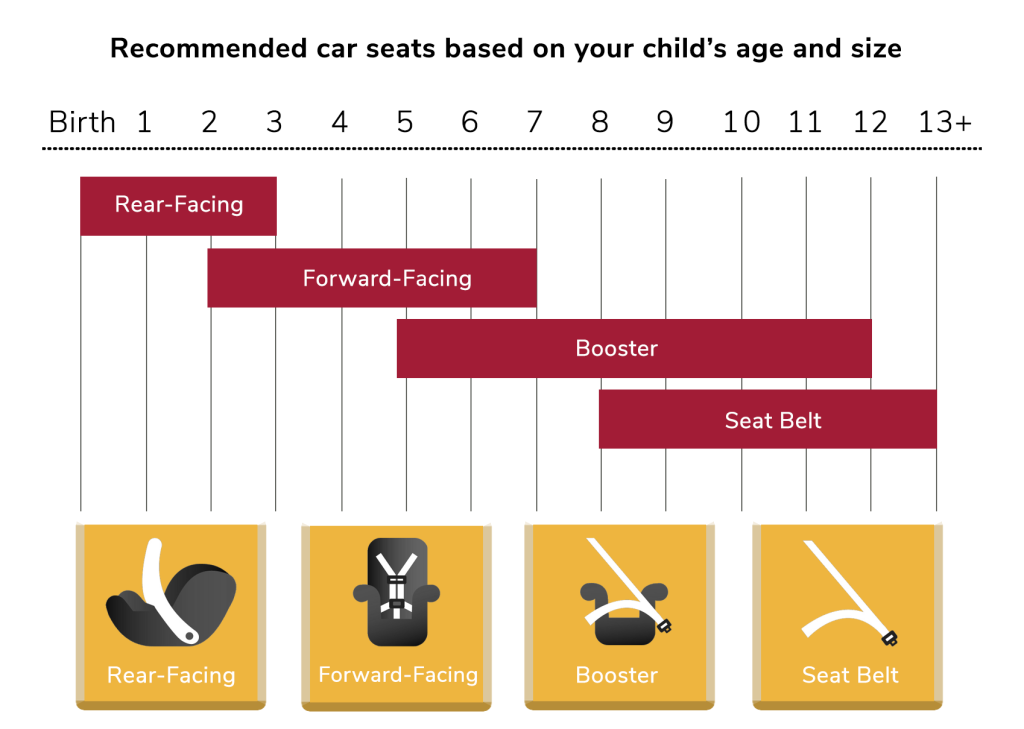
Seat belts save thousands of lives each year. Simply buckling up could be the difference between tragedy and walking away from a car crash with minor injuries. Car crashes are one of the leading causes of child fatalities in the United States, and a portion of those deaths can be attributed to improper car seat or seat belt use. That is why it’s crucial for drivers to be positive role models and establish good lifelong habits for children at an early age. Buckle up so others will too!
Buckling Up the Right Way
Use an Appropriate Child Safety Seat
Seat belts are only effective if they are worn properly.
Rear-Facing Seats
Always use an appropriate safety seat for your child. Maryland law requires children under age 2 in rear-facing safety seats unless they exceed the manufacturer’s height or weight limits. However, it is safest for children to remain rear-facing for as long as possible since this position best supports their neck and spine. Caregivers might be tempted to turn their child’s car seat around early, however, it will increase the risk of injury or death in a crash.
Front-Facing Harnessed Seats
Once a child has outgrown their rear-facing car seat by height or weight, they should be moved into a forward-facing position in a convertible, combination, or all-in-one seat with a harness. This seat should be used until the child outgrows the limits of the harnessed seat, which typically occurs between 5 to 7 years of age.
Booster Seats
After your child has outgrown their harnessed seat, they will likely need to transition to a booster seat. Booster seats operate by raising your child in the seat so that the vehicle seat belt fits correctly across their hips and shoulder. To be booster-ready, your child should be able to sit properly for the entire ride without bending over, slouching, or playing with the seat belt—this typically occurs for most children between 6 and 9 years old.
Know When Your Child is Ready for a Seat Belt and Position it Correctly
The industry standard for determining a child’s readiness to ride safely in the car without a booster seat is commonly referred to as the five-step test. Have your child sit in the seat of your vehicle with a seat belt and observe the following:
- Does the shoulder belt cross between the neck and shoulder?
- Is their lower back flush against the vehicle seat?
- Is the lap belt sitting on their upper thighs and across their hip bones?
- Do their knees bend at the edge of the seat?
- Can they sit comfortably and correctly in this position for the entire ride?
If the answer is “yes” to all of these questions, your child can ride safely without a booster seat. This typically occurs between 8 and 12 years of age or at approximately 4 feet 9 inches in height.
Ride in the Back Seat
Make it a rule: grown-ups ride in the front, kids ride in the back.
While Maryland law does not prohibit children from riding in the front seat, the only safe position in the vehicle for passengers under the age of 13 is the back seat. Frontal airbags deploy at approximately 200 to 400 miles per hour, and most children’s skeletal systems are unable to sustain such an impact without the significant potential for serious injury or death. No matter how much your children plead with you to let them sit up front, keep them safely riding in the back seat.
Motivating Kids to Wear Seat Belts
For Elementary School Kids
Young children respond best to rewards and short-term consequences. Here are some helpful hints:
- No books, toys, or electronic devices until they buckle up.
- Buckle up or the car doesn’t go.
- Explain how seat belts help in a crash.
- Put them “in charge” of seat belt checks.
For Older Children and Tweens
Older children and young teens tend to be more responsive to discussions of longer-term consequences, including legal consequences.
- Explain that most crashes happen close to home.
- Emphasize how car crashes could change your life permanently.
- Buckling up is the law and there are consequences for breaking it.
- Accept no excuses.
Model the Behavior You Want to See
Like many other aspects of life, children learn by observing those around them, specifically their caregivers—whether that behavior is positive or negative. When a driver is unbuckled, 70% of the time the children in that vehicle will also be unbuckled. Adults who choose not to buckle up send a deadly message to children and other passengers that it’s okay not to use seat belts.
As a caregiver, you have the power to instill safe behaviors from the start, empowering the children in your care to keep themselves and others safe by buckling up in every seat, on every ride.
